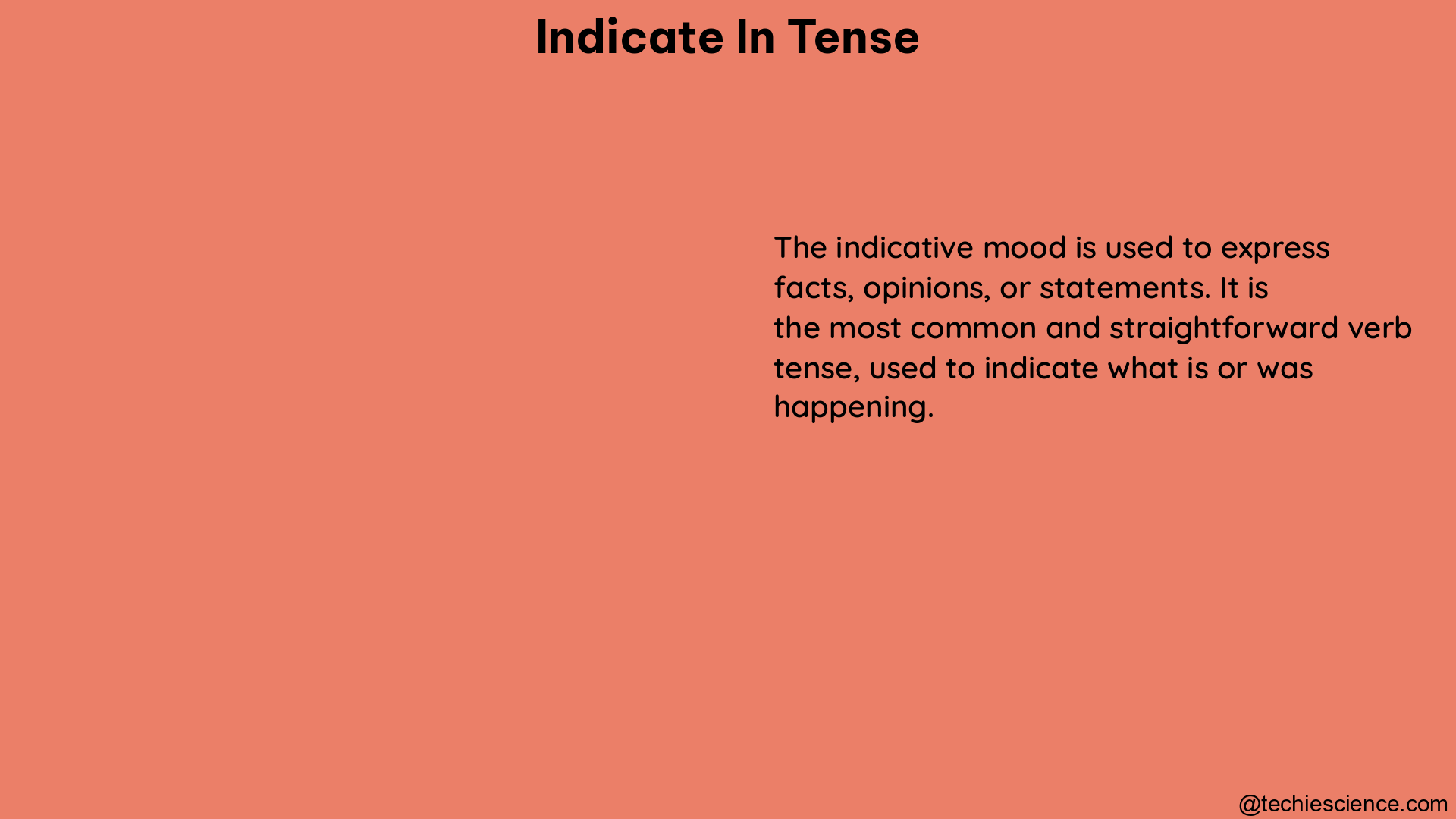The verb “indicate” is a regular verb in English, and its conjugation follows a standard pattern. In this comprehensive guide, we will explore the various tenses of “indicate” with advanced details and grammatical specifications, providing a valuable resource for English language learners and enthusiasts.
Present Tense
In the present tense, the verb “indicate” is conjugated as follows:
Singular:
– I indicate
– You indicate
– He/She/It indicates
Plural:
– We indicate
– You indicate
– They indicate
The present tense is used to express actions, states, or habits that occur in the present time.
Present Continuous Tense

The present continuous tense is used to express an ongoing action or a temporary situation in the present.
Singular:
– I am indicating
– You are indicating
– He/She/It is indicating
Plural:
– We are indicating
– You are indicating
– They are indicating
This tense is formed by using the present tense of the verb “to be” (am, are, is) and the present participle of the main verb (indicating).
Past Tense
The past tense is used to express actions or events that occurred in the past.
Singular:
– I indicated
– You indicated
– He/She/It indicated
Plural:
– We indicated
– You indicated
– They indicated
The past tense of “indicate” is formed by adding the suffix “-ed” to the base form of the verb.
Past Continuous Tense
The past continuous tense is used to express an ongoing action or a temporary situation in the past.
Singular:
– I was indicating
– You were indicating
– He/She/It was indicating
Plural:
– We were indicating
– You were indicating
– They were indicating
This tense is formed by using the past tense of the verb “to be” (was, were) and the present participle of the main verb (indicating).
Past Perfect Tense
The past perfect tense is used to express an action that was completed before another past action or event.
Singular:
– I had indicated
– You had indicated
– He/She/It had indicated
Plural:
– We had indicated
– You had indicated
– They had indicated
This tense is formed by using the past perfect of the verb “to have” (had) and the past participle of the main verb (indicated).
Past Perfect Continuous Tense
The past perfect continuous tense is used to express an ongoing action or a temporary situation that was in progress before another past action or event.
Singular:
– I had been indicating
– You had been indicating
– He/She/It had been indicating
Plural:
– We had been indicating
– You had been indicating
– They had been indicating
This tense is formed by using the past perfect of the verb “to be” (had been) and the present participle of the main verb (indicating).
Future Tense
The future tense is used to express actions or events that will occur in the future.
Singular:
– I will indicate
– You will indicate
– He/She/It will indicate
Plural:
– We will indicate
– You will indicate
– They will indicate
The future tense is formed by using the auxiliary verb “will” and the base form of the main verb (indicate).
Future Continuous Tense
The future continuous tense is used to express an ongoing action or a temporary situation that will be in progress in the future.
Singular:
– I will be indicating
– You will be indicating
– He/She/It will be indicating
Plural:
– We will be indicating
– You will be indicating
– They will be indicating
This tense is formed by using the future tense of the verb “to be” (will be) and the present participle of the main verb (indicating).
Future Perfect Tense
The future perfect tense is used to express an action that will be completed before another future action or event.
Singular:
– I will have indicated
– You will have indicated
– He/She/It will have indicated
Plural:
– We will have indicated
– You will have indicated
– They will have indicated
This tense is formed by using the future perfect of the verb “to have” (will have) and the past participle of the main verb (indicated).
Future Perfect Continuous Tense
The future perfect continuous tense is used to express an ongoing action or a temporary situation that will be in progress before another future action or event.
Singular:
– I will have been indicating
– You will have been indicating
– He/She/It will have been indicating
Plural:
– We will have been indicating
– You will have been indicating
– They will have been indicating
This tense is formed by using the future perfect of the verb “to be” (will have been) and the present participle of the main verb (indicating).
Examples
- Present Tense: “I indicate the direction to the tourists.”
- Past Tense: “She indicated her interest in the project.”
- Future Tense: “They will indicate the changes in the policy.”
Reference Links
- WordReference.com – Conjugation of indicate
- The Conjugator – English verb conjugation TO INDICATE
- Bab.la – How to conjugate “to indicate” in English
Hey! I am Arpita Bose Roy. My qualifications are M.A. in English with B. Ed. in both general education and special education. I have 2 years of experience as a “language analyst” at IIT Kharagpur and 4 years of experience as an “Academic Content Developer” at IIT Kharagpur. Currently, I am working as an academic writer at Lambdageeks.